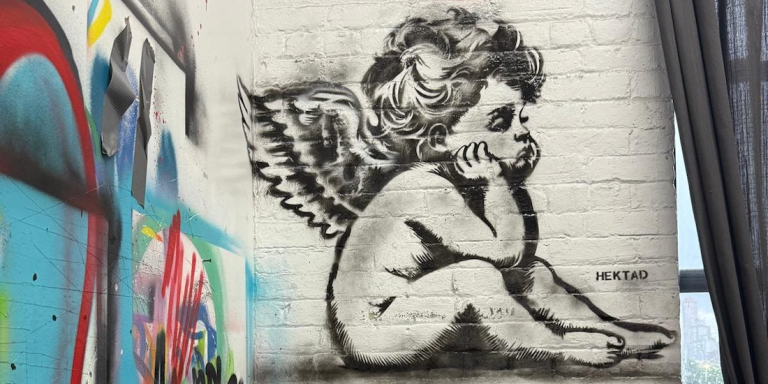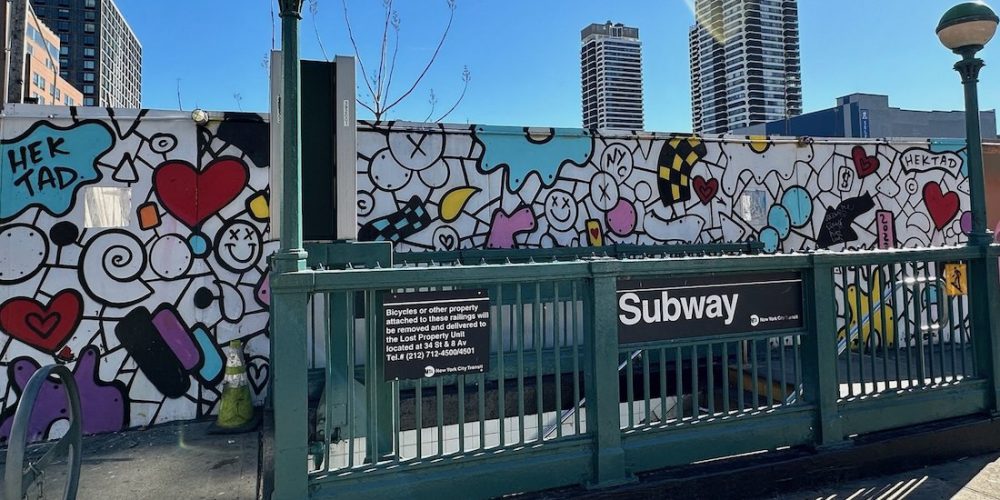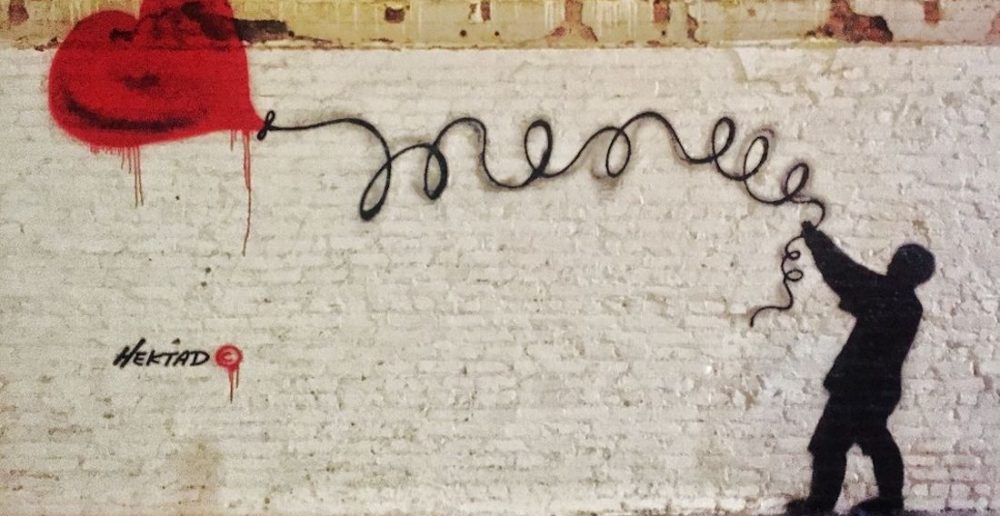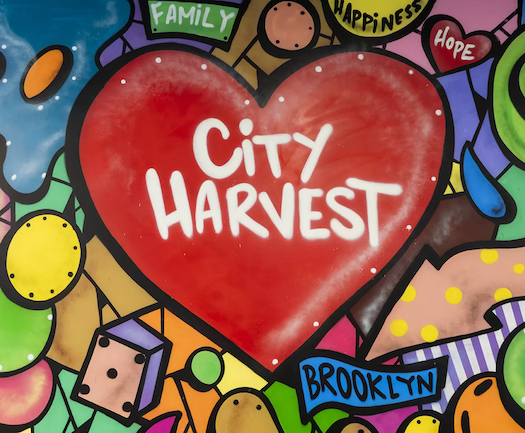
Hektad: Four Decades of Revolutionary Murals Reshape New York’s Visual Identity and Cultural Narrative

New York, N.Y. – In the labyrinthine streets of the Bronx, where concrete walls serve as canvases and creativity flows like urban rivers, one artist has spent over four decades transforming the borough’s visual landscape.
Hektad, known throughout the street art community as the “Bronx Banksy,” has been wielding spray cans and brushes since 1981, creating murals that speak to the soul of New York City’s most vibrant neighborhoods.
The moniker “Bronx Banksy” emerged organically from the street art scene, reflecting both the mysterious nature of the artist’s identity and the profound impact of their work on urban culture. Unlike the elusive British street artist Banksy, however, Hektad has maintained a consistent presence in the community, building relationships with local residents, business owners, and fellow artists who have watched the borough transform through their artistic lens.
From Underground Movement to Cultural Institution
Hektad‘s journey began during the golden age of hip-hop culture and graffiti art, when the Bronx served as the epicenter of a cultural revolution that would eventually spread across the globe. The early 1980s witnessed the emergence of a generation of artists who viewed the city’s walls not as barriers, but as opportunities for expression, social commentary, and community building.
“The streets were our gallery,” Hektad reflects on those formative years. “Every wall told a story, every mural carried a message. We weren’t vandals—we were storytellers, historians documenting the pulse of our neighborhoods through color and form.”
The evolution from clandestine midnight painting sessions to sanctioned public art projects represents more than personal growth; it symbolizes the broader acceptance and recognition of street art as a legitimate artistic medium. Hektad‘s murals have adorned everything from abandoned buildings slated for demolition to commissioned walls in gentrified neighborhoods, serving as bridges between the borough’s past and its rapidly changing present.

Artistic Philosophy and Social Commentary
What distinguishes Hektad‘s work from countless other street artists is the deep philosophical foundation underlying each piece. The murals function as visual manifestations of social justice, community empowerment, and cultural preservation. Through vibrant colors, intricate details, and powerful imagery, Hektad addresses issues ranging from affordable housing and education equity to environmental justice and immigrant rights.
One of the most celebrated works, completed in 2019 on the side of a community center in Mott Haven, depicts intergenerational hands passing artistic tools—spray cans, brushes, and stencils—from elder to younger figures. The mural, titled “Legacy Keepers,” serves as both homage to the pioneers of Bronx street art and inspiration for emerging artists navigating their own creative journeys.
The artistic technique employed by Hektad combines traditional graffiti elements with contemporary mural painting approaches. Bold outlines reminiscent of wildstyle graffiti merge seamlessly with photorealistic portraits and abstract geometric patterns. This synthesis creates a unique visual language that speaks to multiple generations and cultural backgrounds simultaneously.
Community Impact and Cultural Preservation
Beyond aesthetic contributions, Hektad‘s work serves as a form of cultural documentation, preserving the stories and struggles of Bronx communities that might otherwise be forgotten or overlooked.
Each mural functions as a historical marker, capturing moments in time when neighborhoods faced challenges, celebrated victories, or underwent transformation.
Local business owner Maria Rodriguez, whose restaurant has featured a Hektad mural since 2015, describes the impact: “The painting brought life to our corner. People stop, take pictures, ask about the neighborhood’s history. It’s like having a museum right outside our door.”
The artist’s commitment to community engagement extends beyond the creation process.
Hektad regularly conducts workshops for young people, teaching both artistic techniques and the historical significance of street art in urban communities.
These educational initiatives ensure that the tradition continues while evolving to address contemporary challenges and opportunities.

In the Artist’s Own Words
I pinch myself. I have gotten arrested, chased, shot at . . . For doing graffiti, something I love to do. And now I’m getting asked to go all over the world and getting paid. A long time ago, I said, “It isn’t my time. But my time will come.” I feel like my time has come.

I grew up in the projects in the Bronx. We would wait on line at the community center to get beans and blocks of cheese. I remember where I came from.
And for City Harvest to be here and to help people who are less fortunate—it’s awesome.
I had done the tour of the facility and I knew the importance of what City Harvest does for New York City. I stared at the wall and I immediately knew what I was going to do.
I don’t sketch out anything on paper. It took twelve hours. I took the colors of the fruits and the vegetables and put them on the wall. I had about 150 spray cans.
For City Harvest, I wrote, “Never stop loving,” among other things, so that people will relate to that. I want them to take the colors and the love.
I have become known as the heart guy. I have gravitated toward that for many reasons. I want there to be more compassion for other people and more love. I have been doing the heart since back in the 90s.
The City Harvest heart? It’s cool. Anything that has to do with hearts, I love.
Navigating Gentrification and Artistic Integrity
As the Bronx experiences waves of gentrification, Hektad‘s work has become increasingly relevant as both catalyst for change and guardian of community identity. The artist navigates the complex dynamics between urban development, affordable housing, and cultural preservation with nuanced understanding of how art can simultaneously attract investment and displacement.
“Every wall we paint becomes part of the conversation about who belongs in these neighborhoods,” Hektad explains. “We have a responsibility to ensure our art serves the community that raised us, not just the developers who want to profit from our creativity.”
This awareness has led to strategic partnerships with community organizations, tenant advocacy groups, and local government agencies working to balance development with cultural preservation. Hektad‘s murals increasingly incorporate messages about tenant rights, community ownership, and the importance of maintaining affordable housing in rapidly changing neighborhoods.

The author with a mural from Hektad off the Boardwalk at Coney Island in Brooklyn, New York. Nicknamed the “Bronx Banksy,” Hektad has been a prominent figure in the street art scene since 1981. The swing in this mural is held aloft by two heart-shaped red balloons. Photo credit: The Stewardship Report / Jonathan Luce.
Legacy and Future Directions
As Hektad approaches the fifth decade of artistic practice, the focus has shifted toward mentorship and institutional change. The artist collaborates with museums, galleries, and educational institutions to ensure street art receives recognition as a legitimate form of contemporary art while maintaining its roots in community activism and social commentary.
Recent projects include a collaboration with the Bronx Museum of the Arts documenting the evolution of street art in the borough, and partnerships with public schools integrating mural painting into arts education curricula. These initiatives represent Hektad‘s commitment to ensuring future generations understand both the artistic techniques and social significance of street art traditions.
The artist’s influence extends beyond individual murals to encompass broader conversations about public space, artistic freedom, and community empowerment. Through four decades of consistent work, Hektad has demonstrated that street art can serve as a powerful tool for social change, cultural preservation, and community building.
As new challenges emerge—from climate change to economic inequality—Hektad‘s work continues evolving, addressing contemporary issues while honoring the traditions and communities that shaped the artist’s vision. The walls of the Bronx remain canvases for hope, resistance, and transformation, painted by hands that have witnessed and documented four decades of urban evolution.
‘Bronx Banksy’ Transforms Urban Landscapes with Street Art (July 29, 2025)
Summary
Since 1981, Hektad has transformed Bronx walls into powerful canvases addressing social justice, community empowerment, and cultural preservation. Known as the “Bronx Banksy,” this pioneering street artist combines traditional graffiti techniques with contemporary mural painting, creating works that serve as historical markers and catalysts for community engagement, while navigating the complex dynamics of gentrification and urban development.
#BronxStreetArt #UrbanMurals #CommunityArt #SocialJusticeArt #BronxCulture
#StreetArtHistory #UrbanExpression #CulturalPreservation #ArtActivism #PublicArt
TAGS: street art, Bronx murals, Hektad, community empowerment, urban culture, social justice, public art, graffiti history,
cultural preservation, gentrification, hip-hop culture, artistic legacy, Bronx Banksy, mural painting, urban development
